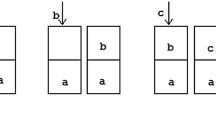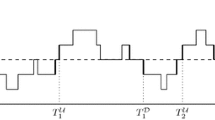Abstract
The idea behind the recently introduced “age-of-information” performance measure of a network message processing system is that it indicates our knowledge regarding the “freshness” of the most recent piece of information that can be used as a criterion for real-time control. In this foundational paper, we examine two such measures, one that has been extensively studied in the recent literature and a new one that could be more relevant from the point of view of the processor. Considering these measures as stochastic processes in a stationary environment (defined by the arrival processes, message processing times and admission controls in bufferless systems), we characterize their distributions using the Palm inversion formula. Under renewal assumptions, we derive explicit solutions for their Laplace transforms and show some interesting decomposition properties. Previous work has mostly focused on computation of expectations in very particular cases. We argue that using bufferless or very small buffer systems is best and support this by simulation. We also pose some open problems including assessment of enqueueing policies that may be better in cases where one wishes to minimize more general functionals of the age-of-information measures.





Similar content being viewed by others
Notes
A point process \(\varphi \) on a product space \(S \times M\) is called M-marked (or just marked) if \(\varphi (\{s\} \times M) \in \{0,1\}\) for all \(s \in S\).
Abbreviations
- \(\delta _x\) :
-
Delta measure at the point x
- \(\overline{X}\) :
-
A random variable with density \(\mathbb {P}(X>x)/\mathbb {E}X\)
- \(T_n\) :
-
Arrival time of a message
- \(\chi _n\) :
-
Accept/reject index
- \(\psi _n\) :
-
Success/failure index
- \(\mathcal {Z}_n\) :
-
Informally, the event that the server is idle just before \(T_n\)
- \(\widetilde{\mathbb {P}}\) :
-
Informally, probability measure governing the stationary system
- \(\mathbb {P}\) :
-
Palm probability of \(\widetilde{\mathbb {P}}\) with respect to the arrival process
- \(\mathbb {P}^*\) :
-
Palm probability of \(\widetilde{\mathbb {P}}\) with respect to reading intervals beginnings \(=\mathbb {P}(\cdot |\mathcal {Z}_0)\)
- \({\mathfrak a}\) :
-
\(= \sum _n \delta _{T_n}\), arrival process as a point process
- \({\mathfrak a}(t)\) :
-
\(=\mathfrak a([0,t))\)
- U(t):
-
\(=\mathbb {E}{\mathfrak a}(t)\)
- Z(t):
-
\(= \mathbb {E}\sum _{i=0}^{{\mathfrak a}(t)-1} T_i\)
- \(W_u(t)\) :
-
\(= \mathbb {E}e^{-u T_{{\mathfrak a}(t)}}\)
- \(V_u(t)\) :
-
\(= \mathbb {E}\sum _{i=0}^{{\mathfrak a}(t)-1} e^{-u T_i}\)
- \(Q_u(t)\) :
-
\(= \mathbb {E}\big \{ (T_{{\mathfrak a}(t)}-t)\, e^{-u T_{{\mathfrak a}(t)-1}} \big \}\)
- \(\sigma _n\) :
-
Processing time of a message
- \(T_n'\) :
-
Departure time of a message either due to successful reading or not
- \(A_t\) :
-
Last arrival epoch before t
- \(S_t\) :
-
Last arrival epoch before t of a successful message
- \(D_t\) :
-
Last departure epoch before t of a successful message
- \(A^*_t\) :
-
\(=S_{D_t}\)
- \(\Delta f(t)\) :
-
\(=f(t+)-f(t-)\)
- \(\tau _n\) :
-
\(=T_{n+1}-T_n\)
- \(B_k\) :
-
Beginning of a reading interval
- \({\mathbf {R}}_k\) :
-
Duration of a reading interval
- \(B_k'\) :
-
\(=B_k+\mathbf {R}_k\)
- \(\mathbf {C}_k\) :
-
\(=B_{k+1}-B_k\), cycle length
- \(\lambda \) :
-
Arrival rate \(=1/\mathbb {E}\tau \)\(=\sum _n \widetilde{\mathbb {P}}(0<T_n<1)\)
References
Kaul, S., Yates, R., Gruteser, M.: Real-time status: How often should one update? In: Proceedings of the 31st IEEE INFOCOM, Orlando, Florida, pp. 2731–2735 (2012)
He, Q., Yuan, D., Ephremides, A.: Optimizing freshness of information: on minimum age link scheduling in wireless systems. In: Proceedings of the 14th IEEE WiOpt, Tempe, Arizona, pp. 1–8 (2016)
Kosta, A., Pappas, N., Angelakis, V.: Age of information: a new concept, metric, and tool. Found. Trends Netw. 12(3), 162–259 (2017)
Bedewy, A.M., Sun, Y., Shroff, N.B.: Minimizing the age of the information through queues (2017). arXiv:1709.04956
Kavitha, V., Altman, E., Saha, I.: Controlling packet drops to improve freshness of information (2018). arXiv:1807.09325
Sun, Y., Kadota, I., Talak, R., Modiano, E.: Age of Information, A New Metric for Information Freshness. Morgan & Claypool Publishers, California (2020)
Baccelli, F., Brémaud, P.: Elements of Queueing Theory: Palm Martingale Calculus and Stochastic Recurrences, 2nd edn. Springer, Berlin (2003)
Daley, D.J., Vere-Jones, D.: An Introduction to the Theory of Point Processes, Volume II: General Theory and Structure, 2nd ed. Springer, New York (2008)
Kallenberg, O.: Foundations of Modern Probability, 2nd edn. Springer, New York (2002)
Kaul, S., Yates, R.D.: The Age of Information: Real-Time Status Updating by Multiple Sources (2017). arXiv:1608.08622
Durrett, R.: Probability: Theory and Examples, 4th edn. Cambridge Univ. Press, Cambridge (2010)
Brill, P.H.: Level crossing methods in stochastic models. In: International Series in Operations Research and Management Science, vol. 123. Springer, New York (2008)
Acknowledgements
We thank Kostya Borovkov for reading an early draft of the paper. We also thank the anonymous reviewers who read the paper carefully, identified all typos, and critically questioned it. Their detailed comments helped us improve the paper.
Author information
Authors and Affiliations
Corresponding author
Additional information
Publisher's Note
Springer Nature remains neutral with regard to jurisdictional claims in published maps and institutional affiliations.
Rights and permissions
About this article
Cite this article
Kesidis, G., Konstantopoulos, T. & Zazanis, M.A. The distribution of age-of-information performance measures for message processing systems. Queueing Syst 95, 203–250 (2020). https://doi.org/10.1007/s11134-020-09655-x
Received:
Revised:
Published:
Issue Date:
DOI: https://doi.org/10.1007/s11134-020-09655-x
Keywords
- Age of information
- Message processing systems
- Palm probability
- Renewal process
- Poisson process
- Performance evaluation
- Stochastic decomposition




